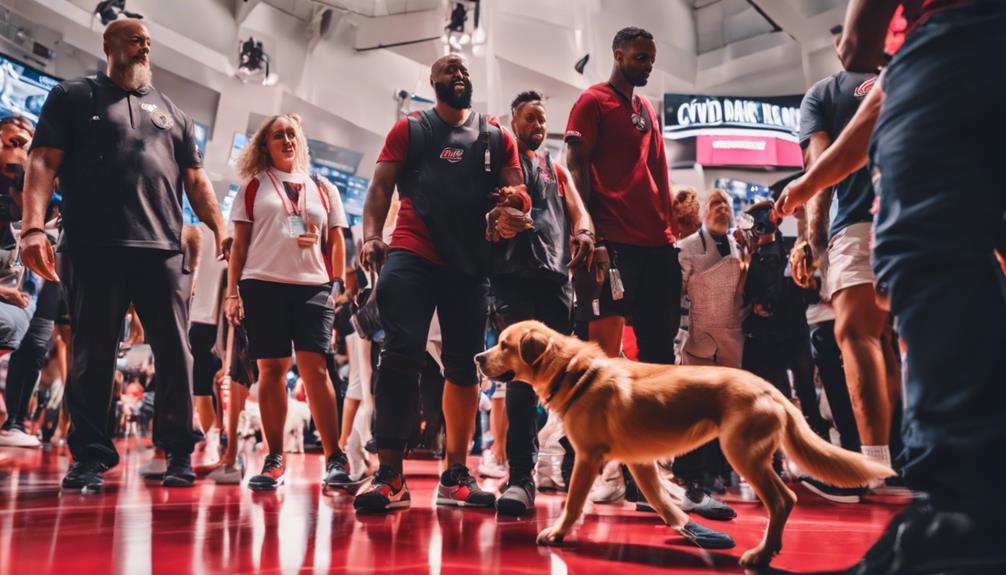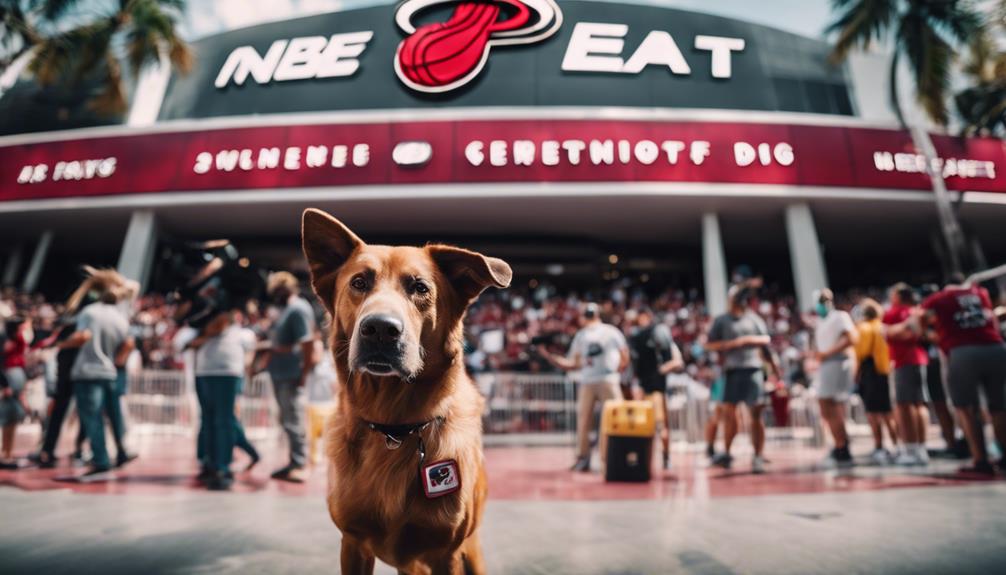In a bold move towards bolstering public health measures at sporting events, Miami Heat's decision to employ COVID-19 detection dogs to screen NBA fans before games marks a notable shift in pandemic safety protocols.
The use of these specialized canines highlights a unique approach to pre-entry screening, enhancing traditional methods with the promise of increased efficiency and accuracy.
As fans eagerly anticipate the return to in-person game attendance, the integration of this canine-led screening process raises intriguing questions about its effectiveness, implications for fan experience, and the broader implications for event safety protocols.
Key Takeaways
- Dogs provide reliable COVID-19 detection at Miami Heat games.
- Dogs enhance screening process for potential cases.
- Safety measures include non-invasive dog screening for fans.
- Efficient and proactive strategy for secure environment.
COVID-19 Detection Dogs' Success Stories
Several success stories around the world highlight the effectiveness of COVID-19 detection dogs in identifying the virus in humans. In Finland, dogs have demonstrated their ability to reliably detect COVID-19 in individuals, showcasing their potential in assisting with screening efforts.
Similarly, detection dogs in the UAE have achieved impressive accuracy rates of over 90% when testing airline passengers for the virus. These achievements underscore the valuable role that specially trained dogs can play in augmenting existing testing methods for COVID-19.
The success of these initiatives not only showcases the capabilities of these detection dogs but also highlights the innovative ways in which they can be utilized in the ongoing battle against the pandemic.
Miami Heat's Innovative Screening Approach
Implementing an innovative approach to screening, Miami Heat is set to utilize COVID-19 detection dogs to ensure the safety of fans entering the arena. This proactive strategy showcases the team's dedication to maintaining a secure environment for all attendees.
The Miami Heat's innovative screening approach includes:
- Enhanced Safety Measures: By employing COVID-19 detection dogs, the team enhances its safety protocols, aiming to detect potential cases efficiently.
- Non-Invasive Screening: The use of detection dogs offers a non-invasive method for screening fans, providing an alternative to traditional testing procedures.
- Efficient Screening Process: The utilization of trained dogs streamlines the screening process, enabling quicker identification of individuals who may require further testing.
Fans' Entry Requirement: Dog Screening

Miami Heat's implementation of COVID-19 detection dogs for fan screening sets a new standard for ensuring a safe environment at their arena. This innovative approach aims to enhance safety measures by detecting potential COVID-19 cases among attendees. The following table illustrates the key requirements and procedures for fans undergoing the dog screening process:
| Fan Screening with Detection Dogs | |
|---|---|
| Step 1: Arrival at the Arena | Dogs conduct initial screening. |
| Step 2: Interaction with Dogs | Fans follow instructions given by handlers. |
| Step 3: Detection Process | Dogs identify potential COVID-19 cases. |
| Step 4: Outcome | Clearance granted for entry if no detection. |
| Step 5: Further Action | Fans detected positive may opt for alternative screening. |
Alternative Screening Option for Fans
An additional screening method is offered to fans as an alternative option to the COVID-19 detection dogs at Miami Heat games. Fans who prefer not to undergo the dog screening can choose to take a 45-minute COVID-19 test instead. This alternative screening option provides fans with a choice in how they wish to ensure their safety and the safety of others attending the games. The COVID-19 test offers a quick and efficient way for fans to demonstrate their COVID-19 status before entering the arena.
- Fans can opt for a 45-minute COVID-19 test as an alternative to the dog screening.
- This alternative screening method allows fans to make a choice based on their preferences.
- The COVID-19 test provides a quick and efficient way for fans to demonstrate their COVID-19 status.
Miami Heat's Safety Measures for Fans

In light of ensuring a safe environment for attendees, Miami Heat has established comprehensive safety measures for fans attending games.
These measures include mandatory face coverings for all fans over the age of two, regardless of vaccination status. The arena has implemented enhanced cleaning protocols, with frequent disinfection of high-contact surfaces.
Fans are encouraged to maintain physical distancing where possible and to practice good hand hygiene. Additionally, the arena has optimized ventilation systems to ensure proper air circulation.
To further enhance safety, Miami Heat has limited seating capacity and staggered entry times to reduce crowding.
These measures aim to prioritize the health and well-being of fans while enjoying the excitement of live basketball games.
COVID-19 Detection Dogs Vs. 45-Minute Tests
Utilizing COVID-19 detection dogs alongside 45-minute tests presents a dual screening approach for ensuring the safety of fans attending Miami Heat games. This combination enhances the efficiency and reliability of the screening process, providing a comprehensive safety net for both fans and staff.
Advantages of COVID-19 Detection Dogs and 45-Minute Tests:
- Complementary Methods: Dogs and rapid tests offer different detection mechanisms, increasing the chances of accurately identifying potential COVID-19 cases.
- Time Efficiency: Rapid tests provide quick results within 45 minutes, allowing for immediate decisions on fan entry.
- Redundancy: Having two screening methods in place reduces the risk of false negatives, offering a more robust safety protocol.
Cats' Susceptibility to COVID-19

Cats demonstrate susceptibility to COVID-19 infection, highlighting the need for understanding and monitoring the potential risks posed to feline populations. Recent studies have shown that cats can contract the virus from humans, leading to concerns about their health and wellbeing.
While cases of COVID-19 in cats are relatively rare compared to humans, the transmission risk remains a significant consideration, especially in households with infected individuals. Veterinarians recommend monitoring cats for symptoms such as respiratory distress, lethargy, and loss of appetite, as these could indicate a COVID-19 infection.
Proper hygiene practices and limiting exposure of cats to potentially infected individuals are crucial steps in protecting feline companions from the virus.
Zoos' Preventative Measures for Animals
Given the increased focus on animal health amidst the COVID-19 pandemic, zoos have implemented stringent preventive measures to safeguard the well-being of their resident animals.
Preventative Measures in Zoos:
- Regular Health Screenings: Zoos are conducting frequent health screenings for animals to detect any signs of illness early on.
- Enhanced Sanitization Protocols: Increased cleaning and disinfection routines are being followed to maintain a hygienic environment for the animals.
- Staff Training and Protective Gear: Zoo staff are trained on proper hygiene practices and provided with necessary protective gear to minimize the risk of transmitting any infections to the animals.
Parvo Treatment and Prevention

Effective treatment and prevention methods are essential in combating Parvo, a highly contagious viral illness that primarily affects dogs. When it comes to Parvo, quick action is crucial to increase the chances of survival. Treatment often involves intensive veterinary care, including intravenous fluids, medications to control vomiting and diarrhea, and sometimes blood transfusions. Prevention is key, and this includes ensuring that puppies are vaccinated against Parvo starting at a young age. Proper hygiene practices, such as disinfecting living areas and avoiding contact with infected dogs, also play a significant role in preventing the spread of Parvo.
| Treatment Methods | Prevention Strategies | Importance |
|---|---|---|
| Veterinary care | Vaccination | Essential |
| Fluid therapy | Hygiene practices | Crucial |
| Medications | Avoiding contact | Significant |
Fading Puppy Syndrome Care Tips
To ensure the well-being of newborn puppies, understanding proper care techniques for Fading Puppy Syndrome is paramount following the discussion on Parvo treatment and prevention methods. Fading Puppy Syndrome, a condition where newborn puppies fail to thrive and may eventually pass away, requires special attention and care. Here are three essential tips to help manage Fading Puppy Syndrome:
- Keep the puppies warm: Maintain a warm and comfortable environment for the puppies to prevent hypothermia, as temperature regulation is crucial for their survival.
- Ensure adequate nutrition: Provide the puppies with proper nutrition, either through their mother's milk or a suitable milk replacer, to support their growth and development.
- Regular monitoring and veterinary care: Monitor the puppies closely for any signs of distress or illness, and seek veterinary assistance promptly if needed to address any health concerns.
Understanding Canine Vestibular Disease

Canine Vestibular Disease, also known as old dog vestibular syndrome, is a condition that affects the balance and coordination of dogs, often presenting symptoms similar to vertigo in humans. This disease can be distressing for both the dog and its owner, as the sudden onset of symptoms like loss of balance, head tilting, and incoordination can be alarming. While the exact cause of Canine Vestibular Disease is often unknown, it is commonly associated with issues in the inner ear or brain. Treatment for this condition typically involves supportive care to help the dog regain its balance and reduce discomfort.
| Symptoms | Treatment |
|---|---|
| Loss of balance | Supportive care |
| Head tilting | Medication for nausea |
| Incoordination | Monitoring for improvement |
Data Processing for Personalized Content
Understanding the importance of data processing for personalized content enhances user engagement and tailors online experiences. Data processing plays a crucial role in delivering customized content to users, ensuring their preferences and interests are taken into account.
Here are three key aspects of data processing for personalized content:
- Data Collection: Gathering relevant information about user behavior, preferences, and interactions.
- Analysis and Segmentation: Processing collected data to identify patterns, trends, and user segments.
- Personalized Content Delivery: Utilizing insights from data analysis to deliver tailored content, recommendations, and advertising to users.
Storage and Access of Information

The secure storage and efficient access of information are critical components in modern data processing systems. Proper management of data ensures privacy and accuracy in processing. Below is a table illustrating key aspects of storage and access of information:
| Storage | Access |
|---|---|
| Data is securely stored in databases or cloud servers. | Authorized personnel can access data through secure login credentials. |
| Regular backups are essential to prevent data loss. | Access controls limit who can view or modify stored information. |
| Encryption techniques safeguard sensitive data from unauthorized access. | Data retrieval methods allow quick and accurate access to specific information. |
| Compliance with data protection regulations is necessary for secure storage. | Access logs track who accessed what data and when for auditing purposes. |
| Monitoring and updating storage systems ensure data integrity and security. | Access permissions can be customized based on user roles and responsibilities. |
User Control Over Data Processing
User autonomy plays a crucial role in determining the extent of control individuals have over data processing activities. Users should have the ability to manage how their data is processed and used by organizations. This control empowers individuals to safeguard their privacy and make informed decisions about their online interactions.
To ensure user control over data processing, organizations should consider implementing the following measures:
- Transparency: Providing clear and easily accessible information about how data is processed.
- Consent Mechanisms: Offering options for users to give explicit consent for specific data processing activities.
- Data Management Tools: Equipping users with tools to review, edit, or delete their data as needed.
Impact of User Choices on Browsing

When considering the impact of user choices on browsing, it is essential to recognize the pivotal role these decisions play in shaping online experiences. User choices, such as selecting preferences, opting in or out of data processing for advertising, and managing privacy settings, directly influence the content and ads presented to them while browsing the internet.
By actively engaging with these choices, users can tailor their online experience to align with their interests and values. Additionally, user choices on data processing can impact the type of data collected about them and determine the level of personalization in advertisements and content they encounter.
Ultimately, the decisions users make while browsing have a significant impact on the relevance and quality of their online interactions.
Conclusion
In conclusion, the integration of COVID-19 detection dogs at Miami Heat games exemplifies a proactive and innovative approach to enhancing public health and safety measures.
By utilizing the incredible olfactory capabilities of these trained canines, the team aims to provide fans with an additional layer of protection against the spread of the virus.
This collaborative effort underscores the commitment to creating a secure environment for attendees and contributes to the broader efforts in effectively managing the pandemic.




